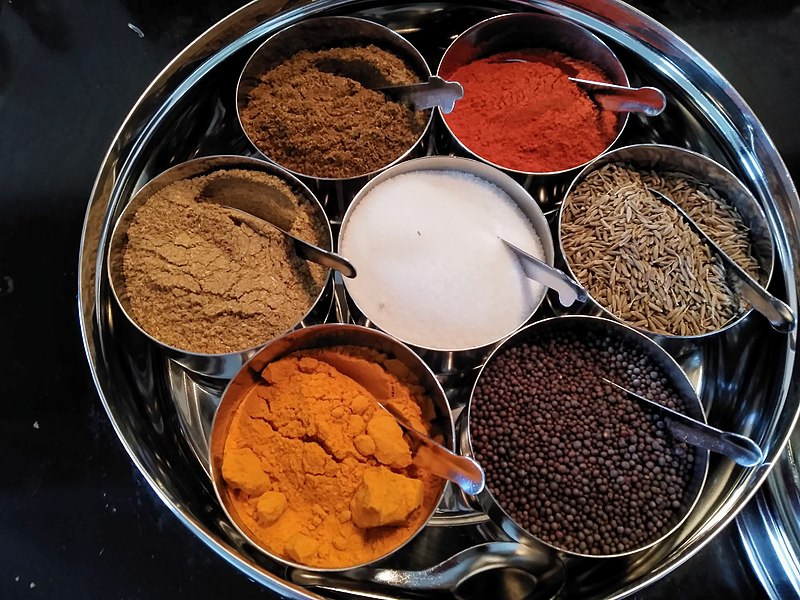Downloads:

Salting
Spices and seasoning
Keywords
Salt, spices, seasoning, herbs, broth, sauce
Level

Salting
Salting is a process used in food preservation. This technique, also known as brining, can be dry or wet.
Dry brining consists of adding salt to food, a substance that has the ability to absorb moisture and reduce the content of water or other liquids in a product, maintaining its softness and quality, and enhancing its aroma and flavor. It is applied to products that are intended to be finished. Wet brining aims to preserve and enhance food flavor.
The penetration of salt and the outflow of water from food is called an osmotic process. This process stops when a balance is reached between the external environment (salt) and the internal one (food). Under the correct conservation conditions, it is possible to obtain a microbiologically and biochemically stable product, increasing its durability and preserving its nutritional characteristics. Salt and other substances are used in canned and preserved foods to increase durability.
Salting is quite old and traditional in different cultures. The Romans, for example, preserved fish, olives, shrimp and cheese with this technique. It was also widely used to preserve meat during wartime, or even appreciated as exchange currency (the 'white gold'). Currently, this technique is still applied to preserve different foods, such as anchovies, herring, cod, meat, sausages, smoked products, cheese, among others.
Spices and seasoning
Spices are individual substances that add their own flavor to food (eg. cinnamon, curry). A condiment is also an individual substance (eg. salt, pepper) or a mixture of several ingredients (eg. curry, mustard), which enhances the flavor of a food. Cheese is also considered a condiment in some European countries.
Seasoning can consist of an individual condiment (eg. salt, pepper) or a set of condiments such as herbs, spices, oils, simple or flavored oils and vinegars, and alcoholic beverages, which are added to a food (before, during or after its preparation/cooking or even just when tasting), in order to confer or enhance its flavor, aroma and color.
Similar to the salting technique, condiments and seasonings are also used to preserve food. Their potential usages can be a valuable ally in the kitchen.
Description
Labels
Benefits
The salting and seasoning techniques maintain the organoleptic properties of the food, and preserve its taste, appearance and odor, without the need for harmful chemical additives, resulting in clear health benefits, when used in adequate amounts. It also precedes the processes of drying, smoking and marinating.
Despite the new conservation techniques that have emerged more recently, there are certain foods that have continued to resist the change of times, especially for their unique aroma and flavor characteristics, such as cod, and several varieties of ham, for example.
Generally, seasoning can be a simple way to reduce or replace salt in cooking, adding new aromas to preparations while promoting health and quality of life. The regular use of these products results in adaptation of the palate and consequent brain modelling, creating the healthy habit of reducing salt or even dismissing it.
A particularly healthy option to maximize spicing and seasoning would be to prepare broths and sauces (with vegetables, meat or fish), and using the less noble parts of the food products (skin, bones, stalks) to enhance flavor, keeping a concentration of nutrients with low levels of salt. These simple procedures improve time and kitchen management and are also an excellent way to combat food waste.
Today, consumers can easily cultivate aromatic herbs at home and encourage the youngest to appreciate and respect nature, while following a healthier diet.
Representative Products
Salting: herring, anchovies, cod, ham, meat and cheese, cold meats in general, sausages.
Spicing and seasoning: olive oil, vinegar, lemon, onion, garlic, salt, aromatic herbs (bay leaf, parsley/coriander, mint, ginger, citronella, paprika, cumin, basil, oregano, peppers, choricero peppers, chilli, thyme, rosemary, lavender, nutmeg, vanilla, anise flower, kefir, and many others).
Risks
One of the factors that influence the development of bacteria is the liquid that is present in food, namely water, used by microorganisms for their growth. Salt, when applied in high concentrations, penetrates food and forces this liquid out through a process of dehydration, hindering the development of microorganisms and promoting food conservation. However, we should not forget that dry and salty foods also deteriorate; therefore, it is necessary to use appropriate packaging and storage space suitable for each product (for example, avoid humidity, store in cool places, protected from light and with adequate ventilation).
To achieve good results with the salting technique, indicators such as the composition of the brining, the shape or thickness of the food, the immersion time in the wet brining, and the ratio between the volume of the brining and the weight of the food should be considered, since they will affect the diffusion of salt in the interior of the food.
For domestic purposes, we should use good quality salt, if possible without impurities, to prevent some mineral contaminants to accelerate oxidative rancidity and reduce the product’s durability.
Salt is our main source of sodium intake, present in a huge variety of foods, especially processed foods. To exceed the limits of salt can cause several health problems, such as high blood pressure. Therefore, it should be consumed with moderation.
Further references
https://www.finecooking.com/article/the-science-of-salt
https://preserveandpickle.com/salt-preserve-food/
https://www.studential.com/university/student-cooking/herbs-and-spices
 Play Audio
Play Audio

